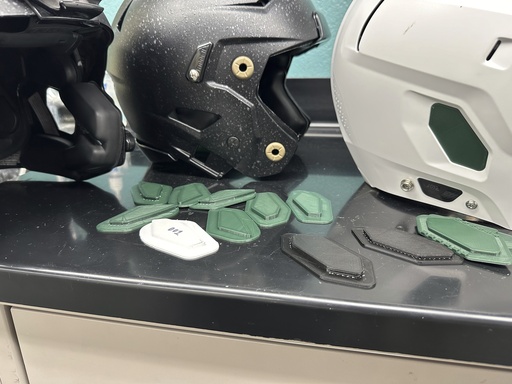
EAST LANSING, Mich. — Watching NFL games from home, Andrew Kolpacki often noticed quarterbacks struggling to hear play calls amid the raucous cheers of thousands of fans. As head football equipment manager at Michigan State, he anticipated that the upcoming change in NCAA rules allowing coach-to-player communications via helmets for the 2024 season would create challenges for the Spartans’ quarterbacks and linebackers. He knew a solution was necessary.
The solution he sought was closer than he expected. Kolpacki contacted Tamara Reid Bush, a mechanical engineering professor and the head of the university’s Biomechanical Design Research Laboratory, who also happened to be a season ticket-holder for the football team. After looking at photos of how other teams had resorted to using duct tape for earhole coverage, Kolpacki asked Bush if there was a more effective option. Her enthusiastic reply was a confident, “Oh, absolutely.”
Working alongside Rylie DuBois, a sophomore in biosystems engineering and research assistant, Bush aimed to create earhole inserts from polylactic acid, a biodegradable plastic, using 3D printing technology. A significant part of the project involved ensuring that the inserts fit varied earhole sizes and shapes dictated by different helmet designs.
The effort came to fruition during Michigan State’s season opener against Florida Atlantic on August 30, when starting quarterback Aidan Chiles and linebacker Jordan Turner donned helmets outfitted with the new inserts to help reduce the impact of crowd noise. DuBois, proudly attending the game from the student section, felt immense pride, sharing with her friends that she had a hand in designing the gear those players wore on the field.
To date, they have produced approximately 180 sets of inserts. The need for this number arose not only from the diverse range of helmet styles and colors worn by Spartan athletes but also from continued refinements to their designs as the season progressed.
Many other collegiate programs are adopting similar initiatives. A significant number have opted for 3D-printed earhole covers from XO Armor Technologies, a company specializing in on-demand athletic wearables. Based in Auburn, Alabama, XO Armor has provided its earhole covers to various schools, including Georgia, Clemson, Boise State, and Arizona State, as part of a concept to establish long-term business relationships, according to Jeff Klosterman, their vice president of business development.
Initially approached by the Houston Texans for assistance with quarterback C.J. Stroud’s communication issues during games, XO Armor was unaware that their solution would attract widespread attention in college football. Following Michigan State’s example, Ohio State also reached out regarding a similar product.
The NCAA rules limit field communication to only one player per team at a time. For the Spartans, that player is typically Chiles on offense and Turner on defense. While Turner prefers inserts in both earholes, Chiles opts to have the aural aid in only one side of his helmet, seeking a balance between hearing instructions and being aware of the field.
Chiles faced some challenging environments, including games at storied venues such as Michigan Stadium and Autzen Stadium, where crowds surpassed 110,000 and nearly 60,000 fans, respectively. Kolpacki remarked on the deafening atmosphere created by such enthusiastic fans, which adds to the difficulty of executing play calls.
Bush considered the successful implementation of their design beneficial for everyone involved. Celebrating the collaboration with the football team, she expressed joy in seeing students apply their academic knowledge to create practical solutions that made a tangible impact during competitions.
